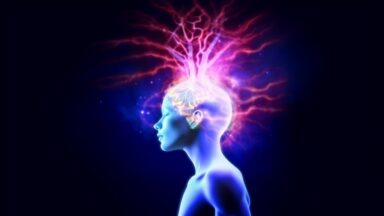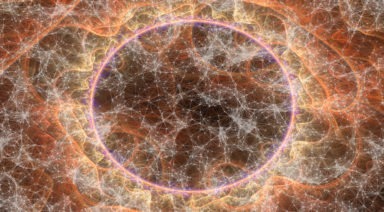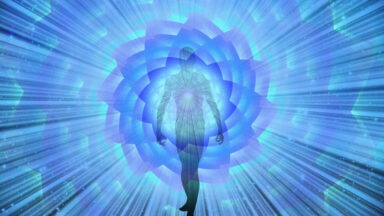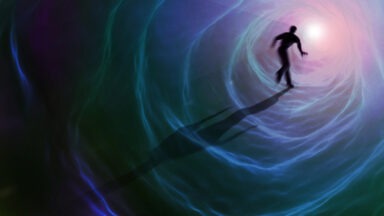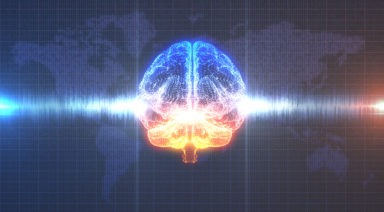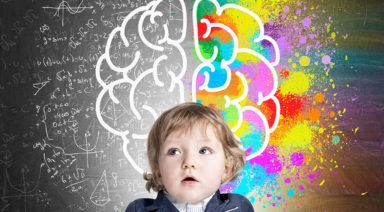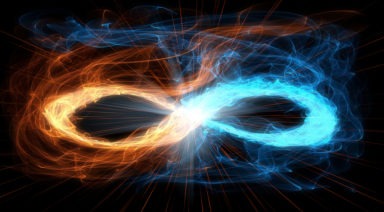Psychic Abilities May Stem From a Field of Consciousness

Ever have the feeling that you know you’re being watched? Or the feeling of thinking about someone just before they call? Some believe these feelings are merely coincidental or just happenstance, but the fact that they are common and something everyone can relate to, leaves open the possibility that there could be a metaphysical mechanism at play. Now, researcher Rupert Sheldrake says he believes these occurrences are due to a psychic phenomenon that is evidence of a collective consciousness and he’s found this theory to show statistical significance.
Sheldrake is most famous for his theory of morphic resonance, a concept that revolves around psychic capability, which he believes is innate in humans and animals. Morphic resonance states that processes and behavior in nature, particularly learned behavior, can be inherited and transmitted psychically. This theory has made him somewhat of a pariah in the scientific community, which labelled him a heretic for entertaining such a seemingly nebulous concept. Nevertheless, he embraces the criticism and continues to pursue his research.
Sheldrake’s Evidence of a Collective Consciousness
In order to test his theory, Sheldrake conducted experiments on a group of subjects to see if they could accurately predict who was calling them on the phone. He ran the test with two groups of callers – one that was known to the subject and another who were complete strangers. The two groups tested against each other to see if there was a notable link between those with an emotional connection.
Sheldrake’s subjects in each test group consisted of four callers, providing for a one-in-four probability. In the group of callers with a strong personal connection to the subject, out of 332 trials among 37 participants, there was a 53 percent success rate of subjects correctly guessing who was calling — clearly better than mere chance. In the group where there was no familiarity, the subject predicted callers with a 25 percent likelihood – the same as chance.
Sheldrake noticed one area of the experiment that might have been flawed was that callers were given a schedule of when they would be calling and could potentially divulge when they’d be contacting the subject next. But when he looked at the results and controlled for this, he found no spikes in successful guessing. Does this hint at a psychic connection between people with a personal bond?
Sheldrake took the experiment a step further and decided to ask subjects to give their level of confidence on whether they would accurately guess a caller. They could either say they felt confident, not confident or just guessing. With this factor, results changed dramatically. When subjects felt confident, they responded correctly 82 percent of the time. When they were unconfident they were correct 35 percent of the time, and when they were just guessing their guess was only correct 25 percent of the time.
An interesting factor in the experiment is that subjects were sometimes thousands of miles away from their caller. Sheldrake found similar results when conducting tests regarding premonitions on email and text messages received. He also says he believes that while there might have been numerous factors skewing the results, intuition could have affected subjects who were told how they were doing. Overthinking can inhibit intuition and therefore in a scenario where a subject wasn’t being tested or didn’t know they were being tested, they would have possibly had a greater likelihood of knowing who was calling.
A Shared Consciousness with Animals?
Sheldrake conducted similar experiments testing the psychic intuition of dogs and whether they know when their owner is coming home. During one experiment to test this hypothesis, Sheldrake found that a dog went to the window looking for its owner four percent of the time she was out of the house, not intending to come home. However, once she started to make her way back home, the dog was at the window 55 percent of the time.
Sheldrake’s original theory of morphic resonance came from an experiment involving mice. The mice were put through a water maze before they progressively learned how to escape quicker. Their progeny, when put in the same maze, learned how to escape in fewer trials, and subsequently, mice on the other side of the world learned how to escape quickly when put through the same test. The experiment showed evidence that a group of mice could genetically pass down learned behavior and that this behavior could also be transmitted psychically throughout an entire species; almost as if it was being uploaded to the cloud where individual members could collectively download it. This is one premise of Sheldrake’s theory and he says he believes it to be inherent in all species.
What is the Collective Consciousness?
A commonly known theory that bears similarity to morphic resonance is the 100th monkey theory – an anecdotal observation showing signs of psychic learning among monkeys on various islands in the Pacific Ocean. Monkeys on one island purportedly learned behavior from monkeys on another island, once the 100th monkey learned the behavior. Sheldrake says this scenario is evidence of morphic resonance but based on an idea of having to reach a critical threshold. He says he sees the process as more gradual; the greater the number of individuals that learn, the easier a task becomes for the species.

Sheldrake’s theory has some basis in Carl Jung’s idea of a collective unconscious. Jung’s collective unconscious is essentially a foundation of archetypes and psychological motifs that are inherent in humans. It differs from our personal psyches and complexes that are developed individually. Jung even referred to it as a, “psychic system of a collective, universal and impersonal nature which is identical in all individuals.” Sheldrake expanded on this theory, by postulating that this collective psychic system is growing and learning in real-time.
Could this be evidence that as a species we are getting collectively smarter and that our collective consciousness is evolving? Or is the technology and the internet a physical extension of what Sheldrake is describing?
What Are the Akashic Records and What Are They For?

The Akashic Records are energetic archives containing the complete history of every soul. Every thought, word, action, and intention leaves an imprint on this energetic field, sometimes called the Akashic Library. This universal repository preserves past lives, current experiences, and potential future paths, offering insights into the soul’s journey, life’s purpose, and karmic patterns.
What is most astonishing is that anyone can access the Records. Through focused intention, guided meditations, or prayer, you can connect with this source of universal wisdom to gain guidance, clarity, and a deeper understanding of your spiritual path. This article explores what the Akashic Records are, how to access them, the benefits of an Akashic reading, and steps to begin your journey of spiritual growth.
Table of Contents
- What Are Akashic Records?
- History and Origins of the Records
- What Is an Akashic Records Reading Like?
- What Kind of Questions Can Be Asked?
- Are There Any Dangers in Accessing the Records?
- Who Can Read the Akashic Records?
- How to Learn to Read the Akashic Records
- Benefits of Accessing the Records
- Closing Prayer and Integration
What Are Akashic Records?
The Akashic Records are a universal memory of existence, a non-physical, energetic space where every thought, word, action, and emotion is recorded. Sometimes referred to as the Akashic Library, this archive preserves the history of each soul, its past lives, current experiences, and potential futures. It offers a comprehensive perspective on the soul’s journey, linking all beings and levels of existence across time.
The term akasha (or akasa) comes from Sanskrit and means ether or astral light, considered the fifth element in many spiritual traditions. These subtle vibrations capture not only individual life experiences but also universal patterns, providing insight into karmic influences, personal growth, and the soul’s purpose.
For anyone accessing the Records for the first time, the experience can reveal hidden tendencies, unexplored potentials, or connections with loved ones who have passed. The Records are a living resource for spiritual growth, supporting clarity, healing, and understanding in all areas of life.
Accessible through meditation, focused intention, or the guidance of an experienced practitioner, the Akashic Records can provide wisdom about behavioral patterns, relationships, and challenges, serving as a practical tool for navigating your spiritual journey.
In the series Microdose, available on Gaia, the fascinating subject of the Akashic Records is explored, offering practical perspectives for those wishing to deepen their understanding and experience of this universal library.
History and Origins of the Records
The concept of the Akashic Records has roots in both Eastern and Western spiritual traditions. In the East, philosophies have long described akasha as the fundamental etheric fabric of existence, a subtle dimension where all experiences are remembered as vibrations or astral light.
In the West, Helena Blavatsky, founder of the Theosophical movement in the late 19th century, introduced the Akashic Records after her studies and experiences in Tibet. There, monks and mahatmas shared that the records exist in the akasha—a Sanskrit word meaning ether—and are the repository of universal knowledge. Blavatsky claimed she could access them through clairvoyance and psychic abilities, including astral projection, and she shared these insights as part of a broader philosophy of universal wisdom. Her teachings emphasized that human thoughts, words, and actions leave lasting impressions on this subtle field, influencing spiritual understanding and personal growth.
Rudolf Steiner, another influential metaphysician, expanded the Western understanding of the Records, describing them as a source of inspiration for human ideals and evolution. He proposed that the Akashic Records not only preserve past events but also reveal patterns that guide humanity toward harmony, justice, and spiritual development.
During the 20th century, Edgar Cayce, often called America’s “sleeping prophet,” popularized the Akashic Records through his psychic readings. Cayce described how individuals could access the Records of their past, present, and potential futures to facilitate healing, gain clarity about life’s purpose, and understand karmic patterns. He likened the Records to a Book of Life, connecting each person to a universal consciousness and to the broader flow of the soul’s journey.
In the late 20th and early 21st centuries, Linda Howe further advanced the understanding and practice of accessing the Akashic Records. Through her teachings, books, and workshops, Howe developed practical methods for connecting with the Records, emphasizing personal empowerment, spiritual guidance, and insight into one’s spiritual path. Her work has helped make the Akashic Records accessible to a wide audience, bridging historical teachings with contemporary spiritual practice.
Contemporary thinkers such as Ervin Laszlo continue to explore the Akashic Records from both spiritual and scientific perspectives. His “Akashic Paradigm” considers consciousness itself as deeply connected to this universal memory field, bridging spirituality and science and offering a holistic view of existence.
What Is an Akashic Records Reading Like?
An Akashic reading is a sacred encounter where a trained reader accesses the akashic library to share insights and guidance. Unlike fortune-telling, these readings focus on understanding the soul’s journey, exploring past patterns, present challenges, and potential futures.
Key aspects of an Akashic Records reading include:
- Connection and Atmosphere: A quiet, focused environment allows both the seeker and reader to connect deeply with the Records.
- Guided Meditations and Intention: The reader may use guided meditations, prayer, or focused intention to attune to the subtle vibrations of the Records.
- Receiving Insights: Messages may come as intuitive impressions, symbols, images, emotions, or subtle sensations, offering clarity and direction.
- Exploring Themes: Common areas of exploration include the soul’s purpose, relationships with loved ones, karmic patterns, and personal growth along the spiritual path.
- Interpretation and Reflection: The reader helps the seeker understand and integrate the messages in ways that resonate with their life experiences.
Many seekers experience the reading as a fluid, interactive process rather than a strict step-by-step session. Each reading is unique, and the insights often help individuals:
- Gain clarity on life’s purpose
- Understand past lives and karmic influences
- Strengthen psychic abilities and intuition
- Receive guidance on relationships, career, or spiritual decisions
- Deepen self-awareness and personal spiritual growth
For those exploring the Akashic Records for the first time, the experience can be transformative, offering validation, reassurance, and a sense of connection to universal wisdom.
What Kind of Questions Can Be Asked?
Questions in an Akashic Records reading are most effective when they are open-ended and focused on personal insight, spiritual growth, and understanding the soul’s purpose. Instead of seeking simple yes or no answers, the goal is to explore guidance, clarity, and healing.
Common questions include:
- What is my life’s purpose in this incarnation?
- How can I align with my soul’s journey and fulfill my soul’s purpose?
- What lessons or patterns am I carrying from past lives?
- Are there karmic influences affecting my current experiences?
- How can I heal or strengthen relationships with loved ones?
- What guidance can I receive to develop my psychic abilities or intuition?
- How can I navigate challenges along my spiritual path?
- What do I need to release or transform for deeper spiritual growth?
- Are there messages from spirit guides or energies I should pay attention to?
- How can I prepare for major life changes or transitions for the first time?
These questions are intended to open a dialogue with the Records, allowing intuitive insights and guidance to emerge naturally. They help seekers gain a deeper understanding of their life, karmic influences, and the lessons their soul has chosen to explore.
Are There Any Dangers in Accessing the Records?
Accessing the Akashic Records is generally considered safe when approached with respect, intention, and openness. The Records are guided by universal wisdom and protected by benevolent beings, sometimes described as light beings or ascended masters, who ensure that the experience serves the seeker’s spiritual growth.
Key points about safety and guidance include:
- Pure Intention Matters: Approaching the Records with humility and sincere curiosity ensures the information received is aligned with the highest good.
- Guided Connection: Using prayers, guided meditations, or working with an experienced reader helps maintain a protected and focused space.
- No Harmful Energy: The Records are designed to offer insight, clarity, and healing rather than fear or harm.
- Support for First-Time Seekers: Those exploring the Records for the first time often find reassurance, calm, and a sense of connection to universal wisdom.
Rather than posing danger, accessing the Records can provide profound understanding of karmic patterns, personal challenges, and past lives. It fosters empowerment, helps release old attachments, and encourages alignment with one’s life’s purpose.
Who Can Read the Akashic Records?
Reading the Akashic Records is not limited to mystics, mediums, or those with innate psychic abilities. Anyone with curiosity, humility, and a sincere commitment to spiritual growth can learn to access this profound source of guidance.
Key insights about who can read the Records:
- No Special Talents Required: Success depends more on intention, practice, and respect than on innate abilities.
- Beginner-Friendly Access: Working with an experienced Akashic Records reader helps first-time seekers understand the process, interpret messages, and feel comfortable navigating the Records.
- Gradual Mastery: Over time, many individuals learn to open their own Records independently or accompany others during readings.
- Ethics and Responsibility: Workshops, courses, and training programs emphasize ethical principles and proper techniques, ensuring readings honor the privacy and integrity of the seeker.
Learning to read the Records becomes a spiritual path in itself, offering insight into the soul’s journey, helping align with life’s purpose, and encouraging personal transformation.
How to Learn to Read the Akashic Records
Learning to read the Akashic Records involves cultivating spiritual awareness, ethical intention, and consistent practice. Many practitioners begin by studying with experienced teachers such as Linda Howe, who provide guidance on opening and closing prayers, meditation techniques, and methods for interpreting the subtle impressions received from the Records. These teachings emphasize approaching the Records with humility, compassion, and a commitment to the seeker’s highest good.
In addition to formal instruction, numerous books, online courses, and webinars help seekers understand the energetic and vibrational nature of the akashic library. Regular practice through guided meditations, journaling, or mindful reflection strengthens intuition, sharpens psychic abilities, and deepens connection to the soul’s journey. Over time, this ongoing practice allows individuals to access their Records more easily, uncover karmic patterns, and gain insight into their life’s purpose and personal growth.
Benefits of Accessing the Records
Accessing the Akashic Records can provide profound insights and support for both personal and spiritual growth. By connecting with this universal archive, individuals gain clarity about their life’s purpose, uncover patterns from past lives, and better understand karmic influences affecting their present experiences. The Records also offer guidance for nurturing relationships with loved ones, developing psychic abilities, and strengthening intuition along the spiritual path.
Many seekers find that the Records enhance their spiritual journey, offering inspiration for guided meditations and practical strategies for daily life. Insights gained can help release limiting beliefs, heal emotional blockages, and align actions with the soul’s purpose. Whether approached for self-reflection, healing, or exploration of the akashic library, accessing the Records fosters a deeper connection to universal wisdom and encourages meaningful transformation over time.
Closing Prayer and Integration
Every Akashic Records session should conclude with a closing prayer, sealing the connection with gratitude and respect for the wisdom received. A simple example might be:
“I thank the keepers of the Records, my guides, and the universal field of wisdom for their presence and guidance. May these insights serve my highest good and the good of all.”
Integration of the insights is just as important as the session itself. Reflecting through journaling, meditation, or personal contemplation helps ground the guidance from the Records into daily life. Over time, consistent practice with the Akashic Records strengthens connection to the soul’s journey, deepens understanding of the soul’s purpose, and supports spiritual growth. Whether exploring past lives, gaining clarity about life’s purpose, or seeking guidance from loved ones, the Akashic Records become a trusted companion on the path of personal transformation.








